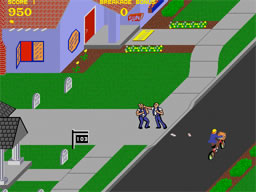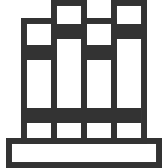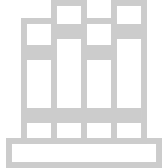“3D models represent a 3D object using a collection of points in 3D space, connected by various geometric entities such as triangles, lines, curved surfaces, etc.” This is a definition taken from Wikipedia and to be honest with descriptions like this chaptering a search on Google, I’m not surprised there is an element of confusion in the industry.
Where it all began?
 I began my computing life using a Commodore 64 back in the 80’s, I won’t go into detail about my age as this is a secret I often lie to myself about. There are many of us that will remember the typical blue screen and the need for patience as the system often got itself into a pickle when trying to start-up. Alas, when you finally got there you were giggling inside not only as a precursor to the upcoming hours of gaming frenzy, but that it was your turn and your brother (or sister) couldn’t get it to work. Paper Boy was my game of choice, yet what stumped me as I continued my adventure into the world of flat 3D pixel art was my ability to forget how difficult it was to control. I spent many a time screaming blue murder at the game, blaming those square shaped cars on the road, the mass of pixels for people, but the true pain in my proverbial behind was those irritating drains that got me every time. To this day I still have not completed the first level and I fear I never will.
I began my computing life using a Commodore 64 back in the 80’s, I won’t go into detail about my age as this is a secret I often lie to myself about. There are many of us that will remember the typical blue screen and the need for patience as the system often got itself into a pickle when trying to start-up. Alas, when you finally got there you were giggling inside not only as a precursor to the upcoming hours of gaming frenzy, but that it was your turn and your brother (or sister) couldn’t get it to work. Paper Boy was my game of choice, yet what stumped me as I continued my adventure into the world of flat 3D pixel art was my ability to forget how difficult it was to control. I spent many a time screaming blue murder at the game, blaming those square shaped cars on the road, the mass of pixels for people, but the true pain in my proverbial behind was those irritating drains that got me every time. To this day I still have not completed the first level and I fear I never will.Inspired to learn more:
 3D art has come a long way since the days of Paper Boy and my beloved Commodore 64, not only in gaming but in practical application. I moved on from the gaming scene at a young age into more creative ventures, namely the one we all cherish being Lego. Those stimulating colourful bricks, the simplicity in its design and the abundance of pieces you could use made for hours of creative fun. Looking back I can actually say that Lego was my inspiration for 3D creative design, as I feel it best defines the concept of 3D modelling. You take different blocks and put them together to create an otherwise completely different, albeit often, unrecognisable shape.
3D art has come a long way since the days of Paper Boy and my beloved Commodore 64, not only in gaming but in practical application. I moved on from the gaming scene at a young age into more creative ventures, namely the one we all cherish being Lego. Those stimulating colourful bricks, the simplicity in its design and the abundance of pieces you could use made for hours of creative fun. Looking back I can actually say that Lego was my inspiration for 3D creative design, as I feel it best defines the concept of 3D modelling. You take different blocks and put them together to create an otherwise completely different, albeit often, unrecognisable shape.
I took my curiosity to many different levels experimenting on building space crafts, planes with 10 wings and cars that could defy gravity, but my passion started when I tried to create existing products like a vacuum cleaner and make it better. On a personal level, have you ever tried to create a vacuum cleaner out of Lego, I kept running out of clear bits, oh how simple things were back then.
3D in the real world:
3D went through many years of transition from simple gaming to what we see today, we all know what the Xbox and Playstation games are like now, they almost immerse you into believing you are in the game. This is what is expected from media in today’s climate, people want to be wowed by realism, shocked by the effects and stimulated by the scenes. This is not only true for games but for practical uses of 3D such as interior design, concept art, prototyping and marketing. 3D technology has come a long way in such a small amount of time, where specialized software allows you to create a fully generated 3D replica of whatever you want. However, it’s not just concepts that can be created it has mechanical and structural applications, where the user can simulate a design, such as a bridge or gear system and test it’s mechanical of material strengths and failures, allowing them to innovate and invent faster and more efficiently, giving us the opportunity to imagine a 3D world, outside of our own.
Changing the face of design:
 I suppose to summarise my endless rant about history in the making and my lack of ability on Paper Boy, I would say that 3D modelling and simulation has changed the face of design and no longer are we limited by our own practicalities, but we can now use our imagination to pave the way for the future. In my opinion to best define 3D design and simulation, you should first understand what you are trying to achieve. In simple terms 3D design is the ability to replicate any physical object into digital art, you can then simulate that model into an animation for visual or practical use. Many would ask why not take a picture and the answer to that is easy. What if you are in a marketing campaign and you need to have visuals on a certain product that is no longer available or is very expensive. Well recreating that product in 3D allows for the marketing shots to be taken from whatever angle, giving you the closest thing to a photo as you can get.
I suppose to summarise my endless rant about history in the making and my lack of ability on Paper Boy, I would say that 3D modelling and simulation has changed the face of design and no longer are we limited by our own practicalities, but we can now use our imagination to pave the way for the future. In my opinion to best define 3D design and simulation, you should first understand what you are trying to achieve. In simple terms 3D design is the ability to replicate any physical object into digital art, you can then simulate that model into an animation for visual or practical use. Many would ask why not take a picture and the answer to that is easy. What if you are in a marketing campaign and you need to have visuals on a certain product that is no longer available or is very expensive. Well recreating that product in 3D allows for the marketing shots to be taken from whatever angle, giving you the closest thing to a photo as you can get.Final thought:
3D is already in our lives in media and marketing, TV and games and soon it will be walking through our homes and defining the limits in which we pose on ourselves. Try to imagine a 3D world and let it change the face of your design and give your creative side a shoulder to lean on when conceptualising and innovating with the use of 3D modelling and design. If you want to give 3D modelling a go, try Microspot’s Interiors Professional for the Mac.




















































